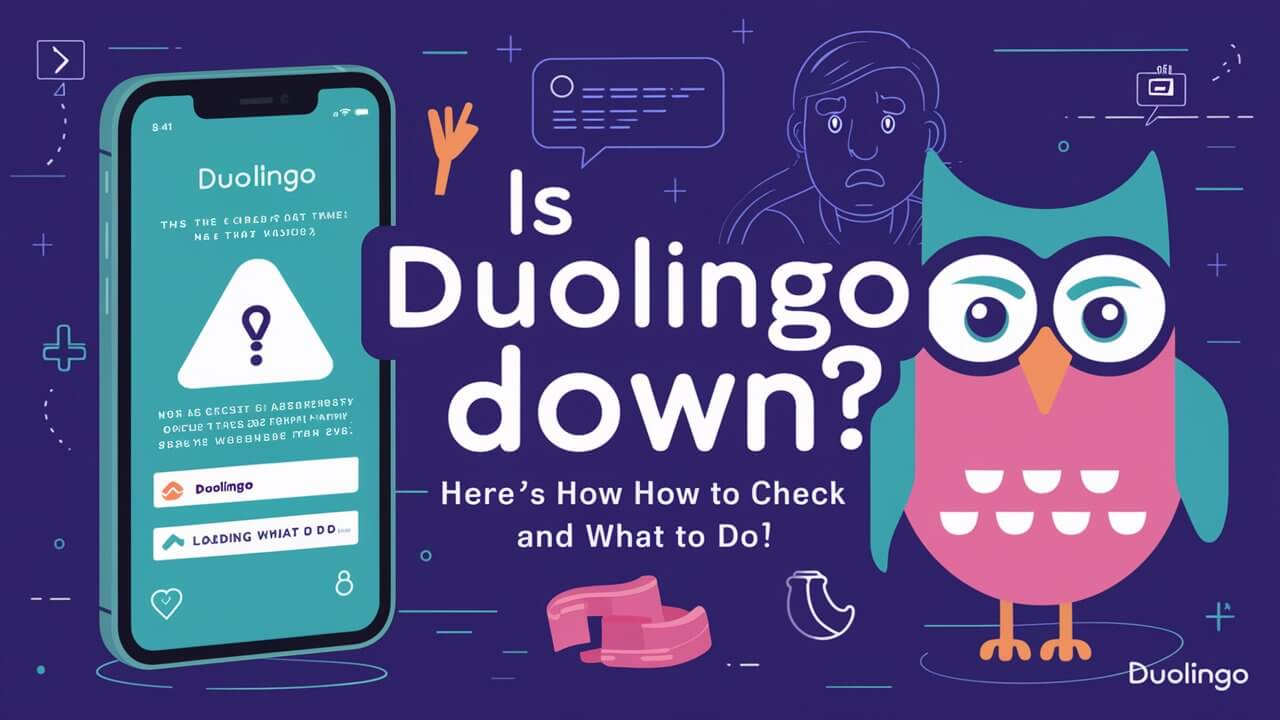Have you been trying to access Duolingo, the popular language learning app, but it seems to be down or not working properly? Don’t worry; you’re not alone. In this comprehensive guide, we’ll explore how to check if Duolingo is down, common reasons for outages, troubleshooting steps, and alternatives during downtime.
The article will cover the following topics:
- What is Duolingo and its features
- How to check if Duolingo is down using official and third-party sources
- Common reasons behind Duolingo outages
- Recent Duolingo outages and issues
- Troubleshooting steps when Duolingo is not working
- Alternatives to Duolingo during outages
- Staying updated on Duolingo’s status
What is Duolingo?
Before diving into the main topic, let’s briefly understand what Duolingo is. Duolingo is a free language learning platform that offers courses in over 40+ different languages. It uses gamification techniques, such as earning points, leveling up, and maintaining a streak, to make language learning fun and engaging.
The Duolingo app is available on both mobile and web platforms, allowing users to practice and learn languages anytime, anywhere. It provides bite-sized lessons, listening exercises, speaking practice, and more to help users improve their language skills.
How to Check If Duolingo is Down
If you’re having trouble accessing Duolingo or experiencing issues with the app or website, the first step is to check if Duolingo is actually down. Here are a few ways to do that:
Duolingo’s Official Status Page
Duolingo has an official status page (status.duolingo.com) where they report any ongoing incidents, outages, or maintenance updates. This page should be your primary source of information to check if Duolingo is down or experiencing any issues.
Third-Party Monitoring Websites
In addition to Duolingo’s official status page, there are several third-party websites that monitor the status of various services, including Duolingo. Some popular options include:
- DownDetector: This website tracks user reports of outages and displays them on a live map. You can check if other users are experiencing issues with Duolingo in your area or globally.
- StatusGator: This platform monitors the status of various services, including Duolingo, and provides detailed uptime and downtime statistics, incident history, and notifications.
- Uptime.com: Similar to StatusGator, Uptime.com monitors the availability of websites and services, including Duolingo, and offers real-time status updates.
Checking Duolingo’s Social Media Channels
Another way to stay informed about Duolingo’s status is by following their official social media accounts. Duolingo often posts updates about outages, maintenance, or any other issues on platforms like Twitter, Facebook, and Instagram. This can be a quick way to get real-time information directly from the source.
Common Reasons for Duolingo Outages
Even though Duolingo is a popular and well-established platform, it can still experience outages or downtime for various reasons. Here are some common causes:
Scheduled Maintenance
Like any other service or application, Duolingo periodically undergoes scheduled maintenance to implement updates, fix bugs, or perform system upgrades. During these maintenance periods, the app or website may be unavailable or experience temporary disruptions.
Technical Issues
Duolingo, like any other software, can encounter technical issues or bugs that may lead to outages or performance problems. These issues can range from server problems to software glitches and may require immediate attention from the Duolingo team.
High Traffic or Server Overload
With millions of users worldwide, Duolingo’s servers may occasionally become overwhelmed by high traffic or usage spikes. This can result in slow performance, loading issues, or even complete outages until the server load is properly managed.
Recent Duolingo Outages and Issues
To give you a better understanding of the frequency and severity of Duolingo outages, let’s take a look at some recent incidents reported by users and monitoring services:
- April 3, 2024: Duolingo experienced a crash on the iOS app when opening it, lasting for approximately one day.
- March 28, 2024: There were increased errors on Duolingo’s platform for about 30 minutes.
- March 26, 2024: Another outage occurred, with Duolingo experiencing increased errors for around 25 minutes.
- March 14, 2024: One of the more significant outages lasted for about three hours, during which Duolingo reported increased errors.
- February 27, 2024: A short outage of 15 minutes was reported, with Duolingo experiencing increased errors.
Duolingo’s outages and issues vary in duration and impact, affecting different parts of its services, such as the mobile app, website, or specific language courses.
Troubleshooting Steps When Duolingo is Down
If you’ve confirmed that Duolingo is down or experiencing issues, but you still want to access the platform or continue your language learning journey, here are some troubleshooting steps you can try:
Checking Your Internet Connection
Before attempting any other troubleshooting steps, ensure that your internet connection is stable and working correctly. Try loading other websites or apps to verify if the issue is specific to Duolingo or a broader internet connectivity problem.
Clearing Browser Cache and Cookies
Clear your browser’s cache and cookies if you’re having issues with Duolingo’s web version. This may resolve the problem and let you access Duolingo smoothly.
Restarting the Device or App
For mobile app users, try restarting your device or force-closing and reopening the Duolingo app. This can often resolve minor glitches or stuck processes that may be causing issues with the app.
Reporting the Issue to Duolingo
If you’ve tried all the troubleshooting steps and Duolingo is still not working, consider reporting the issue directly to Duolingo’s support team. They may be able to provide additional assistance or let you know if they’re aware of the problem and working on a solution.
Alternatives to Duolingo During Outages
While Duolingo is a popular choice for language learning, it’s always a good idea to have backup options in case of outages or downtime. Here are some alternatives you can consider:
Other Language Learning Apps and Websites
There are numerous other language learning apps and websites available, such as Babbel, Rosetta Stone, Memrise, and Busuu. Each platform offers its unique approach to language learning, so you may find one that better suits your learning style or preferences.
Offline Resources
If you prefer a more traditional approach or want to continue learning without an internet connection, consider using offline resources like language learning books, audio courses, or language exchange partners. These methods can be effective supplements to your online language learning journey.
Staying Updated on Duolingo’s Status
To ensure you’re always aware of Duolingo’s status and any potential outages or issues, consider the following options:
Subscribing to Duolingo’s Status Page for Notifications
Many status page services, like StatusGator and Uptime.com, offer subscription options to receive notifications about service disruptions or updates. By subscribing to Duolingo’s status page, you can stay informed about any incidents or maintenance periods that may affect your language learning.
Following Duolingo on Social Media
As mentioned earlier, Duolingo often shares status updates and important announcements on their social media channels. Follow their accounts on platforms like Twitter, Facebook, and Instagram to receive real-time information about outages or other issues.
Using Third-Party Monitoring Services
Third-party monitoring services like DownDetector and StatusGator can be valuable resources for staying up-to-date on Duolingo’s status. These platforms often provide notifications, historical outage data, and user reports, giving you a comprehensive view of the service’s availability.
By following these steps and staying informed, you can minimize the impact of Duolingo outages on your language learning journey and quickly adapt to any disruptions or downtime.
Conclusion
In this complete guide, we’ve explored how to check if Duolingo is down, common reasons for outages, troubleshooting steps, alternatives during downtime, and ways to stay updated on Duolingo’s status. While Duolingo is a reliable and widely-used language learning platform, occasional outages or issues are inevitable.
Knowing how to check Duolingo’s status, common outage causes, and having backup plans helps you continue learning languages without interruptions, even during downtime.
Stay informed about Duolingo’s status through their official page, social media, and third-party monitoring services. This way, you can quickly adapt and switch to alternative resources if needed.
Language learning is a continuous journey, and temporary setbacks or outages shouldn’t stop you from reaching your goals. With the right tools and information, you can overcome challenges and keep learning without interruptions.
So, embrace the occasional hiccups, stay informed, and keep practicing. Your dedication and persistence will undoubtedly pay off in the long run, as you become a proficient speaker of your desired language(s).







